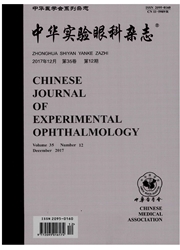

 中文摘要:
中文摘要:
目的探讨重组人瘦素蛋白对体外培养的甲状腺相关眼病(TAO)患者眼眶前脂肪细胞诱导分化的影响。方法体外培养TAO患者眼眶前脂肪细胞,鉴定并传代,设加入不同质量浓度的重组人瘦素蛋白为瘦素组,另设对照组,进行诱导分化及油红染色,图像分析系统计算分化后脂肪细胞内脂质/核的平均积分光密度(IOD)值。结果体外培养的前脂肪细胞经免疫组织化学染色鉴定为间叶来源。不同质量浓度瘦素组分化后脂肪细胞内脂质/核的平均IOD值呈剂量依赖性降低;50、100、500μg/L瘦素组与对照组相比,差异均有统计学意义(P〈0,05)。结论重组人瘦素蛋白能够抑制眼眶前脂肪细胞的分化和细胞内脂质的形成,提示瘦素可能在TAO的发病中起反馈调节作用。
 英文摘要:
英文摘要:
Background Thyroid-associated ophthalinopathy (TAO) is characterized by increased amount of orbital fat tissue. Leptin is a specific adipocytokine, and it may play an important role in the pathogenesis of TAO. Objective The present study investigates /be effect of rb-leptin on the differetltiation of orbital preadipocytes in subjects suffering from thyroid- associated ophthahnopathy (TAO). Methods The orbital fatty tissue was obtained from 7 patients with TAO during orbital decompression surgery. Orbital preadipocytes were cultured using the explant method and differentiated cells were identified with oil red staining. The subcultured preadipocytes were incubated with different concentrations of rh-leptin, and no rh-leptin was added in the control group. The average optical density of cytoplasm/nucleolus in differentiated adipocytes was measured by oil- red staining to evaluate the influence of different concentrations of rh-leptin on lipid formation of orbital adipocytes. Results Cultured preadipocytes in vitro were identified to be of mesenchymal origin by immunohistochemical staining. The average optical density of cytoplasm/nucleolus was 1.07 ± 0.22,0.80 ± 0. 17,0.56 ± 0. 11,0.25 ± 0. 10, and 0. 17 ± 0.08, respectively in the control group, 10 μg/L of leptin group,50μg/L of leptin group, 100 μg/L of leptin group and 500 μg/L of leptin group, showing a significant difference among the five groups ( F = 20.64,P = 0.00). Compared to the control group, the lipid formation of orbital adipocytes gradually declined in various concentrations of rh-leptin ( P 〈 0.05, P 〈 0.01 ). Conclusion Rh-leptin may suppress the differentiation and lipid formation of TAO orbital preadipocytes in vitro in a dose-dependent manner. Leptin may be a feedback modulator in TAO pathogenesis.
 同期刊论文项目
同期刊论文项目
 同项目期刊论文
同项目期刊论文
 期刊信息
期刊信息
